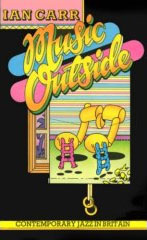Home » Jazz Articles » Book Review » Ian Carr: Music Outside
Ian Carr: Music Outside
 Music Outside
Music Outside Ian Carr
Hardcover; 204 pages.
ISBN: 978 09550908 6 8
Northway Books
2008
This is the republication of a book first published in 1973, and as such—and without the benefit of rose-tinted nostalgia—it offers a snapshot of a British jazz scene that was extraordinarily vibrant and diverse. Trumpeter, bandleader and author Ian Carr was ideally placed to chronicle the events and personalities of the era, and his story reveals a scene that was creative despite, rather than because of, the artistic establishment of the day.
Discussion of that broader picture falls outside the scope of this review; but what Carr's book emphasises is that the music was often the result of dogged persistence and determination on the part of certain individuals, battling against establishment indifference and/or hostility.
Carr's decision to focus on individuals was a wise one, as it allows the reader to get a grasp of just what was happening creatively at the time. The discography at the back of the book serves the same purpose, and also affords the chance to appreciate the extent to which the music was preserved on record. The fact that no more than roughly half of it has been reissued in the meantime is something other than a cause for celebration.
That said, the seeming prevalence of domestic public indifference throws into stark relief the fact that the music was released to start with. Time and again the issue of how much more work the musicians could get in mainland Europe offers no little insight into what might be called the British attitude. In particular, the chapter on pianist and composer Mike Westbrook has some pertinent points to make about the economics of bandleading, points which the passing of time has done little to alter.
In face of widespread indifference and philistinism, the herculean efforts of the likes of drummer John Stevens and saxophonists Evan Parker and Trevor Watts are thrown into even starker relief. At the time, all three musicians were mapping out the territory of free improvisation and the music they were making was already far outside any mainsteam understanding of what jazz was all about. Their desire for jazz to evolve was at the heart of the matter, and it's to Carr's credit that he gives space to the free improvisation movement despite the fact that he had little love for it himself.
That point is crucial to the book's value today. Carr seemed instinctively to know that partisanship had no place in the music—that it could be perceived as perpetually moving on, and indeed "outside" in more ways than one. Chapters on drummer Jon Hiseman, and on Carr and his band Nucleus, both then key harbingers of jazz-rock, further acknowledge this.
Ultimately this book is a snapshot—but with a resonance far exceeding anything that description implies. The passing of time, and the relative immutability of things in the midst of its passing, have made it that way. On an equally profound level, the very chronicling of the book charts the course of a music that in Britain, at that time, was in the process of coming of age.
< Previous
New York Art Quartet
Next >
Cruxes
Comments
Tags
For the Love of Jazz
 All About Jazz has been a pillar of jazz since 1995, championing it as an art form and, more importantly, supporting the musicians who create it. Our enduring commitment has made "AAJ" one of the most culturally important websites of its kind, read by hundreds of thousands of fans, musicians and industry figures every month.
All About Jazz has been a pillar of jazz since 1995, championing it as an art form and, more importantly, supporting the musicians who create it. Our enduring commitment has made "AAJ" one of the most culturally important websites of its kind, read by hundreds of thousands of fans, musicians and industry figures every month.






















